Frank's travels around Britain 2008.
Arundel.
 I stayed in the service station at
Fontwell close to Arundel. Have have been to this area before & have tried many
times to get the picture of the church & castle arising from the flat
countryside. This time was no different! The first day was really miserable.
From the bridge & bypass I tried to capture that wet overcast feeling. I
can see, that to acquire that picture I have in my minds eye, I shall end up
trying again & again! Arundel Castle was built by the Normans to protect that
vulnerable point to the north of the valley through the South Downs. The town
later grew up on the slope below the castle to the south. I found out that people born in Arundel are known locally as Mullets, due to the presence of the
Mullet (fish) in the River Arun.
I stayed in the service station at
Fontwell close to Arundel. Have have been to this area before & have tried many
times to get the picture of the church & castle arising from the flat
countryside. This time was no different! The first day was really miserable.
From the bridge & bypass I tried to capture that wet overcast feeling. I
can see, that to acquire that picture I have in my minds eye, I shall end up
trying again & again! Arundel Castle was built by the Normans to protect that
vulnerable point to the north of the valley through the South Downs. The town
later grew up on the slope below the castle to the south. I found out that people born in Arundel are known locally as Mullets, due to the presence of the
Mullet (fish) in the River Arun.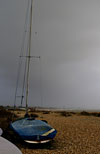
After wandering in the rain I finally found my way to Pagham. Famous, in its own eyes, for the storing of the Mulberry harbours before D Day. It was an overcast, grey & closed sea front that I saw. The amusements arcade closed for the winter, a deserted yacht club & the familiar pebbled beach that stretches from east of Brighton to Bournemouth. A sign told of the Phoenix sections of the Mulberry harbour that can be seen at low tide. They were reinforced concrete caissons, constructed by civil engineering contractors around the coast of Britain, collected and sunk at Dungeness, the Cant and Pagham, and then later re-floated and towed across the channel to form the "Mulberry" harbour breakwaters together with the "Gooseberry" block ships.
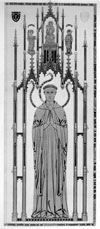 I
found a sad refection of modern England that is now common. I was looking for
photographs & passed through Cowfold, a small village on the way to find a
windmill I knew of. It is the usual upmarket village but this time, it actually
had a shop & people walking around. T
I
found a sad refection of modern England that is now common. I was looking for
photographs & passed through Cowfold, a small village on the way to find a
windmill I knew of. It is the usual upmarket village but this time, it actually
had a shop & people walking around. T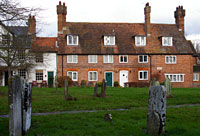 he church
of St. Peter's is lovely, there are bonny
cottages & even a real well with water at the bottom! (They are usually set up
to get people to throw coins in for a local charity) There is a notice outside
to say there is a famous brass rubbing that
commemorates Prior Thomas Nelond, who died in 1432.
he church
of St. Peter's is lovely, there are bonny
cottages & even a real well with water at the bottom! (They are usually set up
to get people to throw coins in for a local charity) There is a notice outside
to say there is a famous brass rubbing that
commemorates Prior Thomas Nelond, who died in 1432.
Of course, the church was
locked up! What happened to sanctuary? Where is the quiet place to go in and
pray? As an atheist, I confess I have no need for this but has England become so
evil & destructive that we can't leave a church open? No doubt, just the
inability to get insurance if the vicar fails to lock it up, is behind it all. The fine brass is kept beneath a
protective padlocked carpet, so is not normally available for visitors to view
anyway. It is, apparently, an elaborate composition, with Nelond praying to
images of the Virgin and child, St Pancras and St Thomas. He is garbed in the
monastic habit - a cassock and a hooded cowl with hanging sleeves.
This is a rare survival of a brass to a monk. Once such compositions would have
been commonplace, but most were destroyed following the dissolution of the
monasteries in the reign of Henry VIII.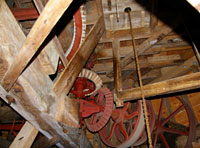
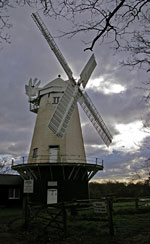 Every
trip I make is always touched by good luck or fate. I had seen a windmill the
last time I had been to the twin mills of Jack & Jill, from their high position
on the Sussex downs. I got my map out, used the Tom Tom sat nav & went off
to see if I could locate it. No problem! Well off the beaten track I found
Shipley Windmill. Not only was it in super nick but volunteers were working on
it and although it was officially closed in the off season, I got a guided tour
& was delighted to chuck in a contribution to the fine work these guys were
doing! Shipley windmill is the youngest and the largest windmill in
Sussex. She - for windmills are always female - has been known at different
times as Shipley Mill, King's Mill, Vincent's Mill and Belloc's Mill. She was
built in 1879 for Mr. Fred Marten by Mr. Grist, millwright of Horsham. She
continued to operate until the end of her active life in 1926. During the time
she was in active work there were seven or eight other windmills within easy
reach. These included Coolham, Cripplegate, Littleworth and West Chiltington.
The number of mills was no doubt due to the dependence on them by local farmers,
and the limited range of the horse-drawn wagons used to deliver the corn and to
collect the meal after grinding. It was such a fortunate opportunity to meet the
guys who where doing all the work. The size of the beams alone, made you realise
that you can't nip to B&Q to get the bits. Finding trees this mature to harvest,
dry out & make into working items was bad enough (if not impossible) but
the costs would be astronomical.
Every
trip I make is always touched by good luck or fate. I had seen a windmill the
last time I had been to the twin mills of Jack & Jill, from their high position
on the Sussex downs. I got my map out, used the Tom Tom sat nav & went off
to see if I could locate it. No problem! Well off the beaten track I found
Shipley Windmill. Not only was it in super nick but volunteers were working on
it and although it was officially closed in the off season, I got a guided tour
& was delighted to chuck in a contribution to the fine work these guys were
doing! Shipley windmill is the youngest and the largest windmill in
Sussex. She - for windmills are always female - has been known at different
times as Shipley Mill, King's Mill, Vincent's Mill and Belloc's Mill. She was
built in 1879 for Mr. Fred Marten by Mr. Grist, millwright of Horsham. She
continued to operate until the end of her active life in 1926. During the time
she was in active work there were seven or eight other windmills within easy
reach. These included Coolham, Cripplegate, Littleworth and West Chiltington.
The number of mills was no doubt due to the dependence on them by local farmers,
and the limited range of the horse-drawn wagons used to deliver the corn and to
collect the meal after grinding. It was such a fortunate opportunity to meet the
guys who where doing all the work. The size of the beams alone, made you realise
that you can't nip to B&Q to get the bits. Finding trees this mature to harvest,
dry out & make into working items was bad enough (if not impossible) but
the costs would be astronomical.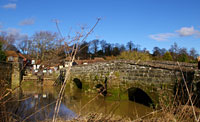 I was grateful the people like this were around & willing to keep trying to
preserve our national hertitage.
I was grateful the people like this were around & willing to keep trying to
preserve our national hertitage.
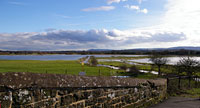 There is a village called Pulborough with two bridges. One for modern traffic
& the original one that probably can't take the weight anymore. It looks out
over the River Arun across the large flood plain to a backdrop of the
South Downs.
It should find itself located just to the northern boundary of the proposed
South Downs National Park.
Historically, it was a fording place over the River Arun used by the
Romans
who had a station here being one days march from
Chichester
on the London road,
Stane Street.
The
Saxons
bridged the River Arun here and at nearby
Stopham,
north of its confluence with the River Rother . It became an important
watering/overnight halt for cattle drovers providing easy access to water. By
the bridge is a cafe cum antique shop, it makes real toasted sandwiches, with
proper ham & oodles of cheese & a good cup of fresh coffee. If you have to spend
too much money, this is a nice place to do it.
There is a village called Pulborough with two bridges. One for modern traffic
& the original one that probably can't take the weight anymore. It looks out
over the River Arun across the large flood plain to a backdrop of the
South Downs.
It should find itself located just to the northern boundary of the proposed
South Downs National Park.
Historically, it was a fording place over the River Arun used by the
Romans
who had a station here being one days march from
Chichester
on the London road,
Stane Street.
The
Saxons
bridged the River Arun here and at nearby
Stopham,
north of its confluence with the River Rother . It became an important
watering/overnight halt for cattle drovers providing easy access to water. By
the bridge is a cafe cum antique shop, it makes real toasted sandwiches, with
proper ham & oodles of cheese & a good cup of fresh coffee. If you have to spend
too much money, this is a nice place to do it.
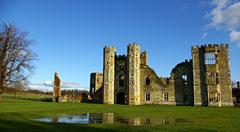 The
surprise of the trip was at Midhurst. First the car park was free ... very
unusual! Then, if I hadn't walked back from the toilets, I would never have seen the
Cowdray ruins at the end of the long road. A strange place indeed.
The
surprise of the trip was at Midhurst. First the car park was free ... very
unusual! Then, if I hadn't walked back from the toilets, I would never have seen the
Cowdray ruins at the end of the long road. A strange place indeed.
Started in the early 16th century on the site of
an earlier building, this noble house became the home of the Browne family,
later the Viscount Montague and a repository of some of the key artefacts from
English history. Its heyday fell during the Tudor period and architecturally I
believe it has be compared to that of many of the great palaces and country
houses of that time (Hampton Court for instance). Its destruction by fire in
1790 was a great loss, but romantic ruins remain to hint at its former glory.

I found it hard to imagine why such a large plot of land was never redeveloped, or some rich person didn't restore the house over all the years from 1790. It could have been the "curse of fire & water" Through the Dissolution of the Monasteries by Henry VIII between 1536-3, Easebourne Priory was disbanded and the Prioress and her nuns ordered to leave. At the time of eviction, the Sub-Prioress pronounced a curse of fire and water on the male children and their heirs of he who takes these lands and it shall come upon him and his name shall die out. There is an excellent website written by Nigel Sadler. He has gathered a mass of information & presents it well. He certainly put some work into there.
 Attached
to the ruins is the Walled Garden. In 2001 while searching for new premises for
her award winning garden company, Room in the Garden, Jan Howard was introduced
to a totally neglected secret garden concealed within its original Tudor brick
walls adjacent to the historic Cowdray Ruins. She was immediately inspired and
agreed
Attached
to the ruins is the Walled Garden. In 2001 while searching for new premises for
her award winning garden company, Room in the Garden, Jan Howard was introduced
to a totally neglected secret garden concealed within its original Tudor brick
walls adjacent to the historic Cowdray Ruins. She was immediately inspired and
agreed a lease with the Cowdray Estate which enabled her to restore the ancient
garden to her own design in sympathy with its history. This privately funded
restoration project was completed in 2005 thanks to Jans vision and energy and
the support of The Cowdray Estate and The Walled Garden Sponsors. The cafe there
is superb. Of course, coming from t'north, you need a second mortgage to buy
anything! I had the most stunning, perfect & mind blowing chocolate brownie &
cafeteria of perfect coffee. It would be niggardly of me to mention that it
needed nuts in the mixture but my God was it good! The gardens were
"complimentary" in the off season. (Please note, only down south are things
complimentary when they are free!) The lady said there were 8000 bulbs to come
up in the season. It will be good, if it's anything like the cakes!
a lease with the Cowdray Estate which enabled her to restore the ancient
garden to her own design in sympathy with its history. This privately funded
restoration project was completed in 2005 thanks to Jans vision and energy and
the support of The Cowdray Estate and The Walled Garden Sponsors. The cafe there
is superb. Of course, coming from t'north, you need a second mortgage to buy
anything! I had the most stunning, perfect & mind blowing chocolate brownie &
cafeteria of perfect coffee. It would be niggardly of me to mention that it
needed nuts in the mixture but my God was it good! The gardens were
"complimentary" in the off season. (Please note, only down south are things
complimentary when they are free!) The lady said there were 8000 bulbs to come
up in the season. It will be good, if it's anything like the cakes!
Links for information on this page:
